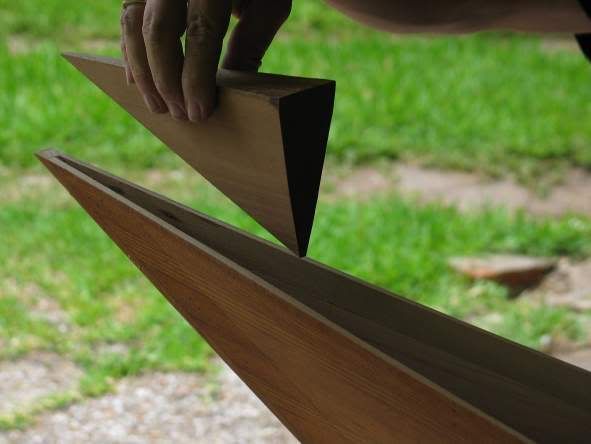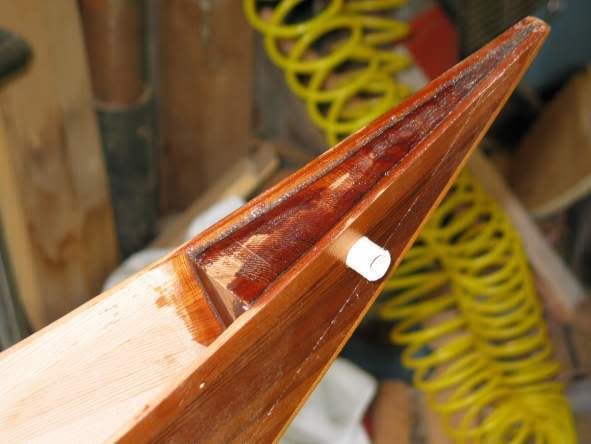Builders' Forum |
|
| ↓ Scroll to Last Comment ↓ | Forum Guidelines | Builders' Forum | |
I'm sure this has been discussed before, so I tried searching many different ways and could not find what I was looking for. It would be great if postings were cataloged by key word ex. boat, subject matter etc.
Okay on to my question, on my SW17 I used wood flour for fillets and straight epoxy for end pours On my next build I want to try saving some weight. Would I save that much weight using micro balloons for each? How do they look for fillets? clear? I know I used to much epoxy making my bulk heads smooth, can I get away with just one coat and leave a rough finish? In fact the underside of my deck is smooth to, With out going too extreme how much can I save on a 45 lb. boat? 1,2,5 lbs.? Any tips would be appreciated.
Phil
15 replies:
RE: Saving weight
Wes,
Thanks for the tips. Do you have any pictures of your boat online? Were the builds pretty much the same?
Phil
RE: Saving weight
You can find lots of photos and detailed descriptions of my experiences building three kayaks at my website www.twofootartist.com
-Wes
RE: Saving weight
Wes,
What is the critical area in doing end pours if I cut down on the amount used to save weight? This is my first try at this whole thing and light weight is one of my goals.
Mike
RE: Saving weight
Light weight happens to be my personal OCD, I love the challenge -- and results! I say that 99% of excess weight comes from excess epoxy, which contributes little, if anything, to strength. My latest boat, an 18' x 21"Outer Island sea kayak that is fully fitted and rigged came in at 30.5 lbs all up, and I couldn't be happier. Here are my tips:
Watch each and every ounce that goes into your project; if you can possibly do without it, then by all means do without it.
Use 4 oz cloth instead of 6, and double up where/if needed. 4 oz cloth requires far less fill coating. Opt for s-glass for max strength.
NO NO NO to end pours!! Carve cedar blocks instead, install with a bed of thickened epoxy to "finalize the fit". remember, less epoxy = less weight, so the better the fit the less thickened epoxy you'll need.
Don't use fiberglass "tape", but rather, cut strips on the bias from 4 oz s-glass instead. It's probably even stronger, since all the fibers cross the seams, not just half of 'em.
Thickening epoxy with wood flour isn't a probem; making oversize fillets is. Make smaller fillets. If in doubt, make test samples to destroy, so you can see for your own self what it takes to cause a failure. I'll bet you'll be very surprised. My fillets are pretty petite, like maybe 3/8" max.
The lightest kayak I've built yet was a 17'-4" x 19" hybrid using 4mm okoume on the hull and .22" cedar strips for the deck. 27 lbs all up and ready to go. So I don't think okoume vs. cedar strips is a big argument.
I think using minimal epoxy is.
Seal coats are mandatory in my lightweight OCD book. Use minimal epoxy to do it, the idea is to neutralize wood pores, not saturate grain. You're better off with too little than too much. Challenge yourself to see just how little goo you can use buut still get complete covereage. Pretend epoxy costs $10K per ounce. Don't worry about splotchy appearance, this is an early stage and everything will end nicely.
Always use enough epoxy to satisfy cloth wet-out requirement fully, but not a gram more. Do not starve cloth, but do not float it or leave pools either. You should have a very distinct and fully transparent weave in plain evidence upon intial wet-out.
Just my opinion........ 
RE: Saving weight
Here's another picture, just because I suddenly learned how to post 'em here. Also meant to give my web site address, with lots more hints and tips: www.sawdustfactory.net .

RE: Saving weight
Good tips Kurt. I am also in the no endpur camp. I used a piece of julatong which is very light.
I have just purchased plans for a Pax 20 which I intend to build as a surfski. I already have a commercial ski which weighs 15kg, so 15 is my goal weight. the internal surfaces will be sealed (bung for release of air when not in use)
I would be interestd in your thoughts on the following;
Do the fillets need to be taped?
a seal coat of penetrol/polyurethane on the internal surfaces rather than epoxy.
4oz bias cut cloth on keel and chine only.
RE: Saving weight
Craig, the first rule of building ultra light is that you must regard everything you try as experimental, perhaps with emphasis on the 'mental' part. The only real way to discover critical strength requirents is to break stuff, just as the only way to nail down the tipping point of a hull is to go splash.
All the ideas you bring up -- assuming untaped fillets is one of them -- certainly sound worth trying. At least, none of them sound alarming or crazy to me. Remember, professionals who cater to the public provide certain margins to keep everyone safe and alive, so the plans make boats that are over-built to a more or less degree.
My motto has always been "If it breaks I'll fix it and make it stronger." And know what? I have seldom had to fix anything because I built it too light. I have plenty of repairs under my belt from bashing and smashing and otherwise acting nutty as a squirrel turd, but hardly ever from simply having built too daintily.
I wanna build a Pax 20 too, one of these days, except mine will be sea kayak style so I can have roto-cooling. :-)
RE: Saving weight
My CH 18 - ready for painting is only 39lb, and the spec says 48lb.
I have not really been trying to be ultra-light, just sensible along the way. I have done several mods that have actually added at least 2-3lb to the weight as well.
The whole Idea of pouring 1/2 a pound of epoxy into the ends just sounded silly to me! What I did instead, was to soak apiece of tape in epoxy, push it all the way into the end, then stand the boat up, and pour an additional 2oz of epoxy into the end so it was all along the stem and stern seams - It is Heaps strong enough and saves a whole lot of un-necessary weight.
I too think that 6oz cloth on the bottom is an overkill - a 4 oz skin and an extra bit on each end would be more than enough - next boat will be only 4oz on the bottom.
I would still use 6oz inside the cockpit - as this area will take the most abuse.
Going totally without tape over the fillets is something that I would not consider - I did the fillets first (very small) then taped later - the tape alone added a heap of strength the the build. But that being said, I only taped the front and back compartments as the 6oz in the cockpit gave the required strenght in this area.
Yes, building as presented is probably a bit on the over-engineered side, but goung ultra-light if you are miles off shore is not really that safe either.
Lets face it, rather than try and save an extra 5lb on the build, go to the gym and lose 10 - you will be better off :)
RE: Saving weight
Keeping things light is, as you put it, only sensible. Building ultra light is experimental. Two different things.
RE: Saving weight
I also did end blocks, sicne I didn't have the patience to wait for a reasonable weather day in March in Connecticut. Mine aren't as pretty at Kurt's, but they got the job done:
My SW17 came in at 44 1/2 lbs. When I drilled the holes in the ends, I simply gave the hole a healthy coat of epoxy with a q-tip.
RE: Saving weight
I did small end pours because I took so long to build that I was impatient and wanted to get my boat in the water. My Northbay still ended up under 40 pounds. Granted, I didn't varnish the boat and had the absolute minimum of fill coats (probably too little in some places) but she floats well (or did until I removed the deck) and I really like being on the water more than building. I know, it's sacrelege to say that, but it's true.
I removed all stitches, removed a couple of the deck stringers and went fairly light on the fillets but not overly so. I didn't add any hatch stiffeners (with little or no ill effects). I did add under deck glass on the foredeck (to make up for removed "massik" deck beam) and glass in the cockpit and still came out really light.
Your biggest single savings is going to be in your end pours and careful wet-out of your glass so you don't have a lot of extra weight there. Similarly you can cut the sheer clamps down to 1/4 inch wide by 1/2 inch tall instead of 3/4 by 3/4 and they will still function properly. That, along with endblocks instead of end pours, will save you probably 5+ pounds. Minimalist outfitting helps too.
If you're comfortable modifying design, you can remove some deck stringers and or deck beams in certain designs and save a little weight there. Obviously most of these bits of advice apply only to S&G boats. If you're going to do a stripper next, the big savings comes in no end pours and careful fill coats.
FrankP
RE: Saving weight
Mike,
I missed your question of June 4th on end pours. The answer is to fully seal the seam between the hull and the deck. For that reason, I don't stand the boat on end when doing end pours, but elevate it upside down on a six-foot stepladder. My Merganser (same as Shearwater but bigger) is now on its second full season of heavy use with no problems. It is as close to a perfect sea kayak as I have found for my size, age, and paddling style. -Wes














RE: Saving weight
» Submitted by twofootartist - Mon, 8/23/10 » 8:14 PM
My first kayak build was a SW17 that came in a 47 pounds. My second is a nearly identical but slightly larger Merganser that came in at 42 pounds. Like you, I used far too much epoxy on the first one.
For the fillets, mix wood flour with Cab-O-Sil about 3:1 to get better strength without losing the brown color. Then make them small. A tongue depressor will give you the perfect radius.
For interior surfaces, all you need to do is seal the wood or the cloth. Don't bother filling the cloth weave. You can get the wood surfaces smooth enough with a single coat.
For the end pours, microballoons will keep them light. You can also make them much smaller than CLC recommends. I use West G-Flex (which CLC cells) because it is designed to stick well to cured epoxy and remains more flexible than other types. My pours are three to four ounces each.
For what it's worth - Wes